Noise in the Walls
By Chris Williams on February 26, 2015.

John Maher: Hi, I’m John Maher. Today, I’m here with Tim Chace of Colonial Pest Control. Tim is an entomologist and a pest control technician. Today, we’re talking about noise in the walls.
Welcome, Tim.
Tim Chace: Good morning, John.
First Steps After Hearing Noises in the Wall
John: Tim, someone calls and says, “I hear a noise in my wall.” What’s the first step that you take when that happens?
Tim: John, we get that quite a bit and it’s always a mystery. The first thing we do is go in and interview the folks asking, “Where do you hear it? When do you hear it? What kind of noise are you hearing?” There’s a whole host of animals that could be making noises in the wall. We want to narrow it down to one or two possible suspects depending on the timing of the noise.
Do they hear it in the morning? Do they hear it in the middle of the night? Do they hear it all the time? Is it a thumping? Is it a thudding? Is it a little crackling noise? Is it a light fluttering? Is there some kind of squeaking involved with it?
What other things have you noticed around the yard? Is your pet food disappearing? Does your dog stare at the wall all night long? What factors are happening surrounding this mysterious noise? We can kind of narrow it down from there into potential groups of things, whether it’s a mammal pest or an insect pest of some kind.
Typical Animals Causing Noises in the Wall
John: What are some of the typical animals that might be living in the walls of my house that might be making these noises?
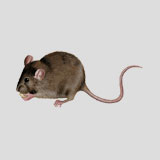 Mice
Mice
Tim: The number one noise producer by far would probably be the house mouse. Mice generally are foraging for food constantly and then storing their food ‑‑ typically nuts, acorns, little seeds ‑‑ in various locations so they can find that in the winter. Mice are pretty much the number one animal and mice will make a little tapping sound, almost like they’re hitting the nut with their teeth, or maybe a light scrambling or rustling.
Sometimes you can hear them actually drop a little acorn. You’ll hear that little falling sound like someone’s throwing a marble up at the ceiling or tapping in the wall just right there. Mice are mostly nocturnal creatures, however sometimes you can even see a mouse running in and out of its little opening. Sometimes you’ll see that.
You might notice that the dog food is missing from the bowl or the dog doesn’t eat a lot or you find a whole bunch of half eaten dog biscuits and mouse poop up inside the couch. That could be an indication that you’ve got a mouse issue.
John: You said that they’re nocturnal generally. If you hear these little noises, like you said, of acorns being rolled around and that sort of thing — you’re hearing that maybe early in the morning or late at night — that might be a sign that there are mice.
Tim: Yeah. Mice are pretty busy throughout the entire winter. We get an awful lot of calls from mouse noises and you can differentiate from that pretty quickly, just based on that little tapping noise.
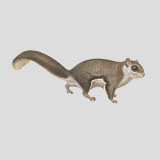 Flying Squirrels
Flying Squirrels
Next up would be our flying squirrels. It’s a very ubiquitous pest. These little guys are able to gain access into very small openings.
John: They’re a very small type of squirrel, right?
Tim: Tiny little guy. They can, just like their name says — they’ll fly from a tree up onto your house so you typically don’t see the flying squirrels but you may find areas where they poop. Flying squirrels will have a latrine up in the attic. So they sleep in one clean section of the attic and then they’ll run over to another spot. So you might see fecal staining on the siding of the house.
The sound that flying squirrels make is very distinctive. It sounds like a little thing really tearing around the wall, going from point A to point B. Kind of hard to describe without making it but it’s been described to me as a pancake on fire.
John: [laughs]
Tim: Or the night circus.
John: [laughs]
Tim: In that particular case, they had over 75 flying squirrels running around over the little girl’s bedroom. She would say, “The night circus. The night circus.” She certainly had a circus going on up there. Again, it’s more of a running sound from point A to point B.
The flying squirrels are really active about an hour before dawn so they’ll be coming back from their nocturnal foraging sessions. They forage for nuts and acorns. Then right around dusk, they’ll be waking up from their daytime sleep and congregating near the openings. They generally won’t leave the house until it’s just about dark.
They’ll take a little run and fly right off the house, into a tree.
Sometimes, if you have really high oak trees next to the house, they’ll climb to the top of the oak tree and just float right back down onto your house so you never really see these little guys. But the noise is quite distinctive.
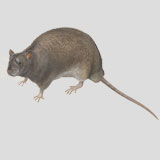 Rats
Rats
Another noise that you could hear inside the wall would be a rat working. Rats are very, very busy creatures. He’s foraging for food. He’s looking for nest sites. He’s investigating his environment. Mice, squirrels, rats and most rodents suffer from a condition where their teeth are constantly growing. In order to keep their teeth from actually growing into their skulls, all these rodents need to constantly chew to file down their teeth.
Even if he’s not feeding, some of these animals will just sit there and chew on the edge of a stud. You’ll find these chew marks next to their openings where he’s just sitting there, chewing the hole, not necessarily making it any bigger but he has to chew that. That can be described just like an incessant scratching, like cha-cha-cha-cha-cha.
Just going, going, and going like a little man on the treadmill. Maybe some movements from point A to point B so you can hear it. “It’s moving through the wall. I can hear it.” He’ll have a route that he travels through the wall. You might even grow accustomed to that.
I had a woman…she could hear the animal. I’m not sure what it was at this point. It would climb over her bedroom, get down to the center wall behind the couch and do some stuff in there for about an hour, then go to sleep. I think that was probably a flying squirrel.
It seems to happen in the morning and it would calm, calm, calm all day. Back in the night time she would hear this thing crawl up through the wall back over her bedroom, then somewhere out.
That was probably a flying squirrel. Other wildlife animals like a chipmunk can sometimes get up under the front steps. I had one a few weeks ago down in…I want to say Marlborough. The woman was very upset because she could hear the exact sound that a chipmunk makes chirping right in her wall and scratching.
It’s like the little chirp that you’ll see on the things sitting out on your stone wall. I said, “Ma’am, that is a chipmunk.” Definitely you have a chipmunk in the wall. Chipmunks don’t generally prefer to live in the house. They would like to be in wildlife, out in the woods somewhere in a nice little hole.
John: Right, they’re in the little holes underground.
Tim: Yeah. They prefer that. Sometimes in their forging, they might enter a structure and get trapped within the wall void or something like that. I had a woman with a gray squirrel. It must have fallen into the wall void space and there was nothing for it to get its claws purchased on. You could hear this poor thing just…
John: Trying to get out.
Tim: …scratching and scratching. It would make it a few feet up the wall. It would fall back down there. Eventually, it died in the wall. At that point she cut a hole in the wall and took it right out.
In most cases, we don’t recommend cutting holes in the wall to investigate because that sound could be coming from anywhere inside the wall and radiating down the construction materials. It’s hard to say that it’s right there in the wall.
John: Right. The likelihood of you cutting a hole on the wall and finding that it’s between those two studs in the wall…
Tim: Right, very rare. You know, and that construction activity might even send it scurrying somewhere else in the wall. So that pretty much covers the mice, rats and the couple of the squirrels.
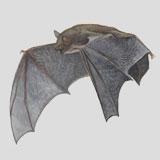 Bats
Bats
John: What about bats?
Tim: Bats will also make a noise. If you get a bat up in the wall void, you could hear some very, very light scratching. Maybe some high pitch little squeaks as they communicate with each other or even a little bit of a flying sort of fluttering sounds as it flies up and down within the wall void. It’s very, very discreet but you can sometimes hear that. I’ve heard it on a couple of occasions.
Insects in the Walls
John: What about insects? Do you hear insects in the wall at all?
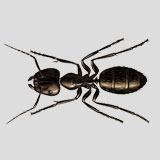 Carpenter Ants
Carpenter Ants
Tim: We certainly do. The two major things that we hear, as far as insects are concerned, the most common by far, would probably be a carpenter ant nest. Carpenter ants are pretty cool little guys. They’ve got six legs. Each of their legs has a little foot on it with four little hooks. You’ll get about 24 little tiny claws per ant.
If you take a carpenter ant and place it on a clean sheet of white paper in a quiet room, as he’s walking up that paper, you can actually hear a very, very discreet scratching sound from one ant going up the paper. If you got a several thousand ants inside the ant nest with each of these little hooks clicking on, clicking on the substrate, you can actually hear a sound that resembles when you pour milk on rice crispies. It just a very light…
John: The crackling sound.
Tim: …crackling sounds. Exactly. Let’s say while the TV is on, the dishwasher’s running, you probably are not going to hear a lot of noise. When the house is really quiet, people would hear the sound. You can actually go right over to the spot. Put your ear on it and hear that rustling sound. If you tap on it, it increases a little bit.
Tim: That’s a great place to drill a hole and kill the ants now, because they’re probably right in there. In some cases the ants aren’t doing a lot of damage to the wood. Carpenter ants don’t physically eat the wood but they nest out galleries inside the wood to store their eggs and larva. Inside this, like a window frame is almost a premade ant nest. The way a premade window fits into the shims and the 2×4 studs.
Lots of little openings there and over time as the ants need more space, they might in fact create some gallery in those wooden members right there. That’s the sound you hear, is all those ants rustling around.
I had a really neat case last year. The ant nest was the whole back side of the house. It was interesting. They had let this house go for some time. When I started injecting some pesticide into the wall on one side of the house, I could actually hear the rustling of the ants increase.
Just on a fluke, I went to two rooms away on the back side of the same wall, and I could hear the ants rustling like crazy where they hadn’t been a few minutes before. I knew the whole wall void system in this whole wall was just…
John: They had moved over to the other side of the house.
Tim: It was just full, but the alarm went off over here as I started to inject, and they were scurrying around. When I went outside, it literally looked like someone was pouring black oil out of the house. There were so many ants leaving the structure.
The home owner was very thrilled to see that.
John: I’m sure.
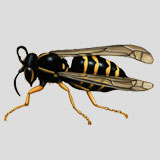 Yellow Jacket Nests in Wall Voids
Yellow Jacket Nests in Wall Voids
Tim: Another one that we hear as far as insects would be a yellow jacket nest within the wall void structure. The queen yellow jacket forms her colony by starting a little golf-ball-size ball. We’ve all seen those on the outside of the eaves of the house. You’ll see a couple of these little paper balls.
That’s the first nest. If that never grows, the queen died and never continued her work. If the queen is successful, that small golf-ball-like nest will actually form the regular nest itself of a yellow jackets’ nest.
It can be several hundred yellow jackets living in that nest. As the nest size increases ‑‑ let’s say they’re within the wall void structure of a house ‑‑ the yellow jackets have no problem removing the sheetrock paper and the sheetrock board to expand that nest size a little bit within the wall void.
That activity can also cause a scratching, buzzing noise. Sometimes we’ll have some folks that hear a funny noise in the wall, and you’ll say, “Ma’am, you’ve got a yellow jacket nest. Look at them coming and going out of the window right there.”
She says, “Oh, we saw that, but we didn’t think that that was in the wall.” In some cases, that yellow jacket nest will break through the wall void, and you’ll wake up and the room is filled with yellow jackets. That’s not a good thing.
John: Any other types of animals that can make noises in the walls? You mentioned to me wasps. Is that yellow jackets – are they a type of wasp?
Tim: That would be the yellow jackets. Sometimes a mud dauber wasp, if he is up inside a window frame and he’s traveling. Let’s say he comes in a little weep hole by the slider and he’s making his little egg chambers up inside the frame. You can hear the little wasp as it travels in there, scratching a little bit and making a little buzzing noise in there. Usually, that’s not a big issue. You just seal up that little hole.
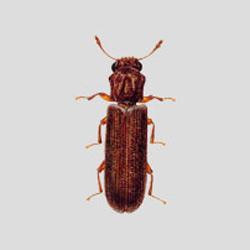 Beetles
Beetles
There are several beetle species that will actually make a noise. The one that comes to mind most notably would be a small beetle they call the death watch beetle. It’s not a very common beetle in the northeast, but this little guy will actually tap its head on the galleries of the wood to attract a mate.
You’ll hear this really light tapping sound. Usually there are not a lot of them, so it’s not doing a lot of damage to the structure, but as the name suggest, back in the old days, they would pre‑make the coffins and this beetle would get in there.
They would set people on a death watch to make sure the person in the box was actually dead. On several occasions they heard a slight tapping on the coffin, which would indicate that the person wasn’t actually dead. It was actually one of the death watch beetles, hence the name. Kind of interesting.
Several other beetle species can make a noise in the wall if you happen to hear them working at just the right moment. The old‑house borer is one. It’s a rather large beetle.
Speaking of beetles, the longhorn beetles, let’s say you brought in some firewood from outside. I have been next to log piles at someone’s house, and she goes, “Can you hear that?” “Yes, I can. that is a beetle chewing inside the wood.” The larvae have really big mandibles that gouge out a little gallery for this thing. It’s actually feeding on some of the wood material in there as it grows.
John: When you bring in the firewood from outside, they’re actually living inside those logs and you don’t even know it.
Tim: We’ve had cases of what they would call cockroaches. It’s actually a beetle infestation hatching out from the log that they’ve brought in from outside. These guys think it’s now summer time. They complete their development…
John: Right, because it’s warmer in the house.
Tim: Exactly. They’ll have 400 or 500 of these little orange beetles on the cellar window, and I’ll go, “Not much to do here. It’s just a one‑time event from the firewood.” They’re not going to re‑infest the house or cause any health issues. It just happened.
John: It sounds like there are a lot of different animals that could be making noises in your walls and in your house. Probably a good idea to call somebody like Colonial Pest Control and say, the typical question, “I have a noise in my wall, what is it?” Then have somebody come out and take a look.
Other Causes of Noises in the Walls
Tim: There could be mechanical causes of noise, too. There was some type of…it was like a timer on the woman’s boiler. Something would happen, and this little gear would start to turn for about 12 or 13 minutes. And she sat in this one chair and she could just hear this little grinding. It’s just a fluke that I happened to be…
John: She thought, “Oh, it’s an animal.”
Tim: It’s something.
John: Yeah, you figured it out.
Tim: I’ve been in a house where there is an arching wire. She’s like, “I hear this little popping sound.” I was like, “That sounds like an electrical issue to me.”
John: Wow, you could have saved that person from having their house being burnt down.
Tim: Absolutely. There was another case recently where they did have a mouse issue, but on the exterior siding of the house, the actual vinyl was melted. I said, “You know, this feels warm.”
Well, the mice had chewed the wire of the outlet right there inside the house, and that outlet services a couple TVs or something. A big power, so that outlet was always warm. The mouse had gone in there because it’s nice and warm, and because mice always need to chew. A wire looks just like a little vine or a root so he chewed that bare.
They almost had another fire just like that. As it turns out, rodents are one of the leading causes of unknown-origin house fires. Just for their propensity to chew things because they have to.
John: If you hear mice or rodents inside the walls of your house, it’s best to get it taken care of right away.
Tim: Give someone a call. There is no need to let a noise go for an indefinite period of time. The quicker you get something addressed, the less likely that you’re going to have some type of adverse event.
John: Great advice. Tim Chace, thanks very much for speaking with me today.
Tim: Thanks, John.
John: For more information you can visit the Colonial Pest Control website at colonialpest.com, or call 1‑800‑525‑8084. That’s 1‑800‑525‑8084.